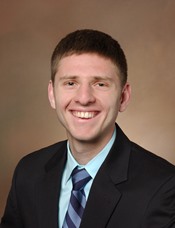Program Information
4DCT-Ventilation: A Novel Imaging Modality for Thoracic Surgical Evaluation
Y Vinogradskiy1*, M Jackson1 , L Schubert1 , B Jones1 , R Castillo2 , E Castillo3 , T Guerrero3 , J Mitchell1 , B Kavanagh1 , M Miften1 , (1) University of Colorado Denver, Aurora, CO, (2) University Texas Medical Branch of Galveston, League City, TX, (3) Beamont Health System, Royal Oak, Michigan
Presentations
WE-AB-BRA-6 (Wednesday, August 3, 2016) 7:30 AM - 9:30 AM Room: Ballroom A
Purpose: The current standard-of-care imaging used to evaluate lung cancer patients for surgical resection is nuclear-medicine ventilation. Surgeons use nuclear-medicine images along with pulmonary function tests (PFT) to calculate percent predicted postoperative (%PPO) PFT values by estimating the amount of functioning lung that would be lost with surgery. 4DCT-ventilation is an emerging imaging modality developed in radiation oncology that uses 4DCT data to calculate lung ventilation maps. We perform the first retrospective study to assess the use of 4DCT-ventilation for pre-operative surgical evaluation. The purpose of this work was to compare %PPO_PFT values calculated with 4DCT-ventilation and nuclear-medicine imaging.
Methods: 16 lung cancer patients retrospectively reviewed had undergone 4DCTs, nuclear-medicine imaging, and had Forced Expiratory Volume in 1 second (FEV1) acquired as part of a standard PFT. For each patient, 4DCT data sets, spatial registration, and a density-change based model were used to compute 4DCT-ventilation maps. Both 4DCT and nuclear-medicine images were used to calculate %PPO_FEV1 using %PPO_FEV1=pre-operative FEV1*(1-fraction of total ventilation of resected lung). Fraction of ventilation resected was calculated assuming lobectomy and pneumonectomy. The %PPO_FEV1 values were compared between the 4DCT-ventilation-based calculations and the nuclear-medicine-based calculations using correlation coefficients and average differences.
Results: The correlation between %PPO_FEV1 values calculated with 4DCT-ventilation and nuclear-medicine were 0.81 (p<0.01) and 0.99 (p<0.01) for pneumonectomy and lobectomy respectively. The average difference between the 4DCT-ventilation based and the nuclear-medicine-based %PPO_FEV1 values were small, 4.1±8.5% and 2.9±3.0% for pneumonectomy and lobectomy respectively.
Conclusion: The high correlation results provide a strong rationale for a clinical trial translating 4DCT-ventilation to the surgical domain. Compared to nuclear-medicine, 4DCT-ventilation is cheaper, does not require a radioactive contrast agent, provides a faster imaging procedure, and has improved spatial resolution. 4DCT-ventilation can reduce the cost and imaging time for patients while providing improved spatial accuracy and quantitative results for surgeons.
Funding Support, Disclosures, and Conflict of Interest: YV discloses grant from State of Colorado
Contact Email:

